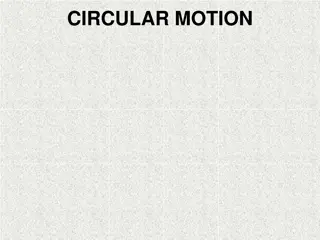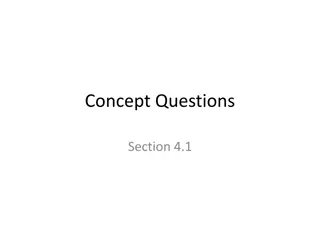Circular Motion Revision for AQA Syllabus
Circular motion involves experiencing a centripetal force leading to acceleration toward the center of a circle. Understanding angular speed, centripetal force, and the equations associated with circular motion are crucial for a comprehensive comprehension of this topic. An example problem and Newton's Gravitation Equation are also covered.
Download Presentation

Please find below an Image/Link to download the presentation.
The content on the website is provided AS IS for your information and personal use only. It may not be sold, licensed, or shared on other websites without obtaining consent from the author.If you encounter any issues during the download, it is possible that the publisher has removed the file from their server.
You are allowed to download the files provided on this website for personal or commercial use, subject to the condition that they are used lawfully. All files are the property of their respective owners.
The content on the website is provided AS IS for your information and personal use only. It may not be sold, licensed, or shared on other websites without obtaining consent from the author.
E N D
Presentation Transcript
Gravity and Circular Motion Revision AQA syllabus A Section 13.3.1-6 B.W.Hughes BWH 10/04 AQA 13.3.1-6 1
Circular motion When an object undergoes circular motion it must experience a centripetal force This produces an acceleration towards the centre of the circle BWH 10/04 AQA 13.3.1-6 2
Angular Speed Centripetal Force BWH 10/04 AQA 13.3.1-6 3
Angular speed Angular speed can be measured in ms-1 or Rads-1 (radians per second) or Revs-1 (revolutions per second) The symbol for angular speed in radians per second is BWH 10/04 AQA 13.3.1-6 7
Converting to To convert v to = v/r To convert revs per second to Multiply by 2 BWH 10/04 AQA 13.3.1-6 8
Acceleration The acceleration towards the centre of the circle is a = v2/r OR a = 2r BWH 10/04 AQA 13.3.1-6 9
Centripetal Force Equation The general force equation is F = ma so the centripetal force equation is F = mv2/r OR F = m 2r THESE EQUATIONS MUST BE LEARNED!! BWH 10/04 AQA 13.3.1-6 10
Example Gravity provides the accelerating force to keep objects in contact with a humpback bridge. What is the minimum radius of a bridge that a wheel will stay in contact with the road at 10 ms-1? v = 10 ms-1, g = 10 ms-2, r = ? a = v2/r = g so r = v2/g r = 102/10 = 10 m BWH 10/04 AQA 13.3.1-6 11
Newtons Gravitation Equation Newton s Gravitation equation is F = -Gm1m2/r2 MUST BE LEARNED!! Negative sign is a vector sign G is Universal Gravitational Constant BWH 10/04 AQA 13.3.1-6 12
More about the equation m1 and m2 are the two gravitating masses r is the distance between their centres of gravity The equation is an example of an Inverse square law BWH 10/04 AQA 13.3.1-6 13
Gravitational field A gravitational field is an area of space subject to the force of gravity. Due to the inverse square law relationship, the strength of the field fades quickly with distance. The field strength is defined as The force per unit mass OR g = F/m in Nkg-1 BWH 10/04 AQA 13.3.1-6 14
Radial Field Planets and other spherical objects exhibit radial fields, that is the field fades along the radius extending into space from the centre of the planet according to the equation g = -GM/r2 Where M is the mass of the planet BWH 10/04 AQA 13.3.1-6 15
Gravitational Potential Potential is a measure of the energy in the field at a point compared to an infinite distance away. The zero of potential is defined at Infinity Potential at a point is the work done to move unit mass from infinity to that point. It has a negative value. The equation for potential in a radial field is V = -GM/r BWH 10/04 AQA 13.3.1-6 16
Potential Gradient In stronger gravitational fields, the potential graph is steeper. The potential gradient is V/ r And the field strength g is equal to the magnitude of the Potential gradient g = - V/ r BWH 10/04 AQA 13.3.1-6 17
Graph of Field strength against distance 1.2 1 Field strength 0.8 Series1 0.6 Power (Series1) 0.4 0.2 0 0 1 2 3 4 5 6 7 8 9 10 Distance BWH 10/04 AQA 13.3.1-6 18
Field strength graph notes Outside the planet field strength follows an inverse square law Inside the planet field strength fades linearly to zero at the centre of gravity Field strength is always positive BWH 10/04 AQA 13.3.1-6 19
Graph of Potential against distance 0 0 1 2 3 4 5 6 7 8 9 10 -0.2 -0.4 Potential Series1 -0.6 Power (Series1) -0.8 -1 -1.2 Distance BWH 10/04 AQA 13.3.1-6 20
Potential Graph Notes Potential is always negative Potential has zero value at infinity Compared to Field strength graph, Potential graph is less steep BWH 10/04 AQA 13.3.1-6 21
Orbits Circular orbits follow the simple rules of gravitation and circular motion. We can put the force equations equal to each other. F = mv2/r = -Gm1m2/r2 So we can calculate v v2 = -Gm1/r BWH 10/04 AQA 13.3.1-6 22
More orbital mechanics Period T is the time for a complete orbit, a year. It is given by the formula. T = 2 / and should be calculated in seconds BWH 10/04 AQA 13.3.1-6 23
Example The Moon orbits the Earth once every 28 days approximately. What is the approximate radius of its orbit? G = 6.67 x 10-11 Nm2kg-2, mass of Earth M = 6.00 x 1024 kg = 2 / T = 2 /(28x24x60x60) = 2.6 x 10-6 rads-1 F = m 2r = -GMm/r2 so r3 = -GM/ 2 BWH 10/04 AQA 13.3.1-6 24
Example continued r3 = 6.67 x 10-11 x 6.00 x 1024/(2.6x10-6)2 = 5.92 x 1025 r = 3.90 x 108 m BWH 10/04 AQA 13.3.1-6 25
The End! With these equations we can reach the stars! BWH 10/04 AQA 13.3.1-6 26























